Mars Polar Lander Timeline

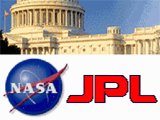 Feb 7, 1994: Program Started. Congress approves funding for the Mars Surveyor Program, which will include two launches to Mars during each two-year
launch opportunity. The first in the series will be the '98 Lander
and Orbiter. The missions will be managed for NASA's Office of Space Science by the California
Institue of Technology Jet Propulsion Laboratory (JPL). The combined
development
cost for the lander and orbiter missions will be $191.3 Million.
This represents a significant challenge, given that the development cost
of the Mars Pathfinder lander alone was $245 Million.
Feb 7, 1994: Program Started. Congress approves funding for the Mars Surveyor Program, which will include two launches to Mars during each two-year
launch opportunity. The first in the series will be the '98 Lander
and Orbiter. The missions will be managed for NASA's Office of Space Science by the California
Institue of Technology Jet Propulsion Laboratory (JPL). The combined
development
cost for the lander and orbiter missions will be $191.3 Million.
This represents a significant challenge, given that the development cost
of the Mars Pathfinder lander alone was $245 Million.
 Mar 17, 1995: Martin Marietta Selected.
JPL selects Martin Marietta Astronautics in Denver, Colorado as the prime contractor for the
Lander and Orbiter flight systems. On March 15, 1995, Martin Marietta Corp. merged
with Lockheed Aerospace to form the Lockheed Martin Corporation. Lockheed Martin
went
on to build both the orbiter and lander flight systems. Parker Stafford was the
Lockheed Martin project manager until his retirement, when the
present project manager Ed Euler was named.
Mar 17, 1995: Martin Marietta Selected.
JPL selects Martin Marietta Astronautics in Denver, Colorado as the prime contractor for the
Lander and Orbiter flight systems. On March 15, 1995, Martin Marietta Corp. merged
with Lockheed Aerospace to form the Lockheed Martin Corporation. Lockheed Martin
went
on to build both the orbiter and lander flight systems. Parker Stafford was the
Lockheed Martin project manager until his retirement, when the
present project manager Ed Euler was named.
 May 1, 1995: Project Manager Named. JPL names John B. McNamee manager of the
newly-formed Mars Surveyor '98 Project. McNamee was also the leader of
JPL's Surveyor Program pre-project study effort. As project manager, McNamee
creates an unusually streamlined management
structure, with minimum staff, a short chain of command, and a short
time-cycle for important project decisions.
May 1, 1995: Project Manager Named. JPL names John B. McNamee manager of the
newly-formed Mars Surveyor '98 Project. McNamee was also the leader of
JPL's Surveyor Program pre-project study effort. As project manager, McNamee
creates an unusually streamlined management
structure, with minimum staff, a short chain of command, and a short
time-cycle for important project decisions.
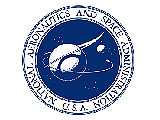 May 8, 1995: Instrument Proposals Solicited.
NASA's Office of Space Science issues an Announcement of Opportunity to the international
science community soliciting
proposals for instruments, or suites of instruments (integrated payloads) for
the Mars Polar Lander. Based on the recommendations of Mars Exploration
Science Working Group chaired by Geoff Briggs of NASA Ames, the overall scientific theme of the mission is
"Mars Volatiles and Climate". The expected capabilities of the lander are outlined, but it is up to the proposors of the integrated payload to suggest specific landing sites.
May 8, 1995: Instrument Proposals Solicited.
NASA's Office of Space Science issues an Announcement of Opportunity to the international
science community soliciting
proposals for instruments, or suites of instruments (integrated payloads) for
the Mars Polar Lander. Based on the recommendations of Mars Exploration
Science Working Group chaired by Geoff Briggs of NASA Ames, the overall scientific theme of the mission is
"Mars Volatiles and Climate". The expected capabilities of the lander are outlined, but it is up to the proposors of the integrated payload to suggest specific landing sites.
 Oct 20, 1995: Instruments Selected.
NASA selects the lander's scientific payload. The selected investigations
are the Mars Volatiles and Climate Surveyor (MVACS) integrated payload, led
by led by David Paige of the University of California, Los Angeles (UCLA),
the Mars Descent Imager (MARDI) led by Michael Malin of Malin Space
Science Systems (MSSS), and a LIDAR instrument to be supplied by the Space
Sciences Institute in Moscow (IKI). Slava Linkin of IKI is named LIDAR principal investigator.
Oct 20, 1995: Instruments Selected.
NASA selects the lander's scientific payload. The selected investigations
are the Mars Volatiles and Climate Surveyor (MVACS) integrated payload, led
by led by David Paige of the University of California, Los Angeles (UCLA),
the Mars Descent Imager (MARDI) led by Michael Malin of Malin Space
Science Systems (MSSS), and a LIDAR instrument to be supplied by the Space
Sciences Institute in Moscow (IKI). Slava Linkin of IKI is named LIDAR principal investigator.
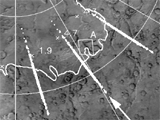 Oct 20, 1995: Polar Landing Site Suggested.
The MVACS investigation will sudy the distribution and behavior of
Martian volatiles at a south polar landing site.
The MVACS team proposes attempting to land on the Martian Polar Layered
Deposits at a latitude of 72 degrees south latitude. The proposed
trajectory had only a 50 percent probability of landing on the layered
deposits, and was barely within the capabilities of the lander design at that point in time.
Oct 20, 1995: Polar Landing Site Suggested.
The MVACS investigation will sudy the distribution and behavior of
Martian volatiles at a south polar landing site.
The MVACS team proposes attempting to land on the Martian Polar Layered
Deposits at a latitude of 72 degrees south latitude. The proposed
trajectory had only a 50 percent probability of landing on the layered
deposits, and was barely within the capabilities of the lander design at that point in time.
 Dec 1, 1995: Project Scientist Named.
Richard Zurek, the original Deputy Principal Investigator of the MVACS investigation is named by JPL as the Mars Surveyor '98 Project Scientist.
Zurek will work with the project to accommodate the lander
and orbiter investigations, and be the prime scientific advisor to the project.
Candice Hansen of JPL replaces Zurek as MVACS Deputy Principal Investigator.
Dec 1, 1995: Project Scientist Named.
Richard Zurek, the original Deputy Principal Investigator of the MVACS investigation is named by JPL as the Mars Surveyor '98 Project Scientist.
Zurek will work with the project to accommodate the lander
and orbiter investigations, and be the prime scientific advisor to the project.
Candice Hansen of JPL replaces Zurek as MVACS Deputy Principal Investigator.
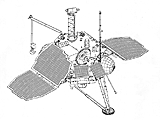 Jan 4, 1997: Lander Design Reviewed.
The Mars Surveyor '98 Project passes it's Confirmation Design Review (CDR).
This top-level review certifies that the design of the lander and its
mission are complete, that the lander's payload is accommodated, and that
the project's cost and schedule are on target. Passing the CDR gives
the project the go-ahead to begin "cutting metal" and begin assembling
the lander and payload.
Jan 4, 1997: Lander Design Reviewed.
The Mars Surveyor '98 Project passes it's Confirmation Design Review (CDR).
This top-level review certifies that the design of the lander and its
mission are complete, that the lander's payload is accommodated, and that
the project's cost and schedule are on target. Passing the CDR gives
the project the go-ahead to begin "cutting metal" and begin assembling
the lander and payload.
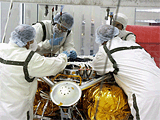 Aug 1, 1997 -
Aug 1, 1997 -
Sep 30, 1998: Lander Assembled and Tested.
The lander is assembled and tested at the Lockheed Martin facility in Denver, CO. The completed MVACS, MARDI and LIDAR instruments are delivered to
Denver and successfully integrated with
the lander. The entire assembly is tested in a realistic Mars atmospheric
and thermal environment.
 Feb 1, 1998: Lander and Orbiter Renamed.
After soliciting input from the project and the public, NASA renames
the Mars Surveyor '98 missions the Mars Climate Orbiter and Mars
Polar Lander missions.
Feb 1, 1998: Lander and Orbiter Renamed.
After soliciting input from the project and the public, NASA renames
the Mars Surveyor '98 missions the Mars Climate Orbiter and Mars
Polar Lander missions.
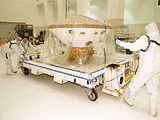 Oct 1, 1998: Lander Shipped to Cape.
The lander is shipped from Denver to NASA's Kennedy Space Center (KSC) via
air cargo transport.
Oct 1, 1998: Lander Shipped to Cape.
The lander is shipped from Denver to NASA's Kennedy Space Center (KSC) via
air cargo transport.
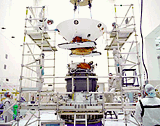 Oct 1, 1998 - Jan 3, 1999: Lander Integrated with Launch Vehicle.
The lander is mated to a Boeing Delta 7429 launch vehicle at Cape Canaveral Air Station and the launch countdown is started. To reach its landing site at 75 degrees south latitude, it must launch during a 7-day primary launch window
which opens on Jan 3, 1999.
Oct 1, 1998 - Jan 3, 1999: Lander Integrated with Launch Vehicle.
The lander is mated to a Boeing Delta 7429 launch vehicle at Cape Canaveral Air Station and the launch countdown is started. To reach its landing site at 75 degrees south latitude, it must launch during a 7-day primary launch window
which opens on Jan 3, 1999.
Next >>
|

